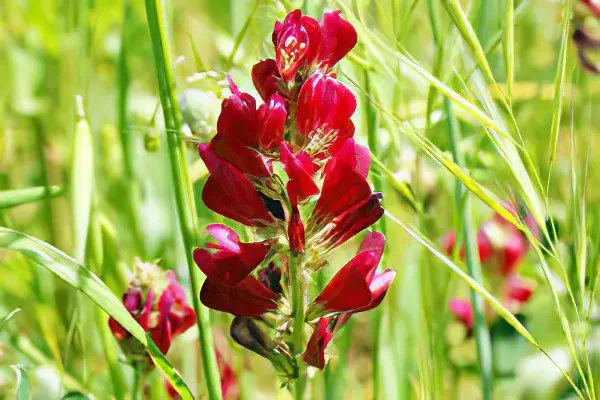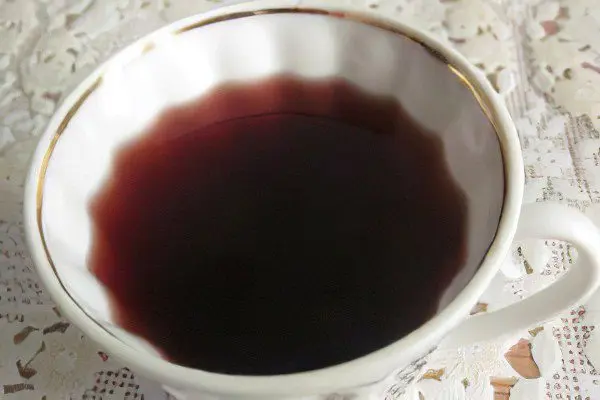Contents
Useful properties and application of red root tincture
Description of the red root

red root is an interesting herbaceous perennial, whose height varies from 25 to 50 cm. It has a long woody root, the length of which can reach 5 meters. When the plant blooms, small purple-violet flowers appear, collected in elegant multi-flowered brushes. The fruit is represented by a drooping fluffy bean with a wide border. Often the plant blooms from mid-June to the end of August. The main habitat is considered to be North America and Europe, as well as North Africa and Asia.
The red root prefers tundra, forests, and also lives in the steppes, meadows and mountain slopes and in river valleys. For medicinal purposes, the collection is carried out in August. For this, adult roots are harvested, leaving a third of them intact. Do not re-harvest in the same place for about 10 years. The flower arrow of this low shrub comes out of small shortened shoots, which often develop at the neck of the rhizome. Numerous erect stems are bare and leafy, their thickness reaches 5 mm.
The pinnate leaves bear about 12 pairs of obtuse, oblong-elliptical or oblong-lanceolate leaf blades. Long dense inflorescences have 20-60 flowers. Long flower stalks are much larger than leaves. Moth-type flowers are located on short pedicels with chic linear bracts. The length of the gray bell-shaped calyx is approximately 3 mm. Its teeth are somewhat longer than the tube. The dark pink corolla is longer than the calyx.
The fruit of the plant is a naked or slightly appressed-hairy bean. It is constricted into several rounded segments. Often some of the ovules are not developed, and the bean itself includes only 2-3 members. They are flattened, have transverse ribs, and are always covered with short setae. The length of kidney-shaped flattened seeds is no more than 3 mm.
Useful properties of the red root
The main active ingredients of the plant are tannins, triterpene saponins, xanthone hedizaride, coumarins, flavonoids, and free amino acids. Its underground part contains a fairly large amount of oligomeric catechins of a special condensed type. It is they who belong to the unique bioflavonoids that color the infusion from the red root in a bright red color.
Since catechins have a fairly high P-vitamin activity, they perfectly restore and strengthen capillary walls, quickly remove various heavy metals from the human body, and can boast of antioxidant activity, neutralizing free radicals. In the aerial part of this delightful plant, in addition to coumarins and tannins, traces of alkaloids, steroidal saponins, macronutrients and xanthones, as well as polystachoside and hyperoside, were found.
Due to the xanthonic glycoside mangiferin, the red root has a high biological activity. Flavonoids were found in the herb of the plant, and ascorbic acid was found in its leaves. Roots and rhizomes contain polysaccharides such as xylose, galactose derivatives, galacturonic acid and rhamnose. The plant is considered a natural non-hormonal stimulant of important sexual activity with a mild, gentle effect, which is important for any man.
The red root also has an excellent stimulating effect on the human heart muscle. For the treatment of various serious diseases of the respiratory tract – both bronchi and lungs, as well as concomitant ailments of the genitourinary system, various preparations with a high content of the red root are shown. In complex therapy with the main medicinal purpose, this plant significantly reduces the intensity of coughing, relieves sputum purulence and generally improves the psycho-emotional status.
The red root normalizes blood counts, reduces the number of diuretic disorders and reduces pain. Such a wonderful expectorant is indispensable in the treatment of respiratory organs. Often, various remedies based on the presented plant are prescribed for acute gastrointestinal diseases. Moreover, the perennial is used as an excellent pain reliever and anticancer agent.
It must be recalled that the plant also has a fairly high immunostimulating effect. In ancient times, red root powder was prescribed for epilepsy as a sedative.
Application of the red root

To prepare healing tea from the red root, you need to take 25 grams of dry raw materials, place it in a thermos and pour two cups of boiling water. It is necessary to insist this remedy for at least one hour. You can take it with the addition of a small amount of honey, sugar or milk. Such a delicious drink with a pleasant taste will help a person cope with numerous colds of an infectious nature.
It can be used for diarrhea, anemia, diseases of the gastrointestinal tract, various headaches, as well as for neurosis and women’s diseases. It has long been considered an excellent tonic and diuretic. In addition, the red root has been proven to have a powerful immune-boosting effect. With chills, hemoptysis and fever, you can recommend a special decoction, which is prepared from the collection of medicinal herbs.
With prostatitis and impotence, an infusion of the red root can be used to make enemas.
In addition, external use is indicated for diseases of the urogenital area, fibromyoma and myoma, 1 tsp will be required to prepare the infusion. mixture and a glass of boiling water. Enemas should be done twice a day. This course of treatment is approximately 12 days.
Red Root Tincture
An incomparable balm from a wonderful red root can be prepared by taking 50 grams of dry raw materials and insisting them in 450 ml of ordinary vodka. The duration of infusion at room temperature should not be less than 7 days. After that, it is recommended to strain such a tincture, and it will be ready for use. Depending on the specific medical indications, the dosage may vary from 0,5 tsp. up to 0,5 st. l. balm should be dissolved in a glass of plain warm water and taken before meals three times a day.
The best course of treatment is always 3 months. If necessary, it can be repeated after a month break. The effect of tincture during treatment is much higher than when using special tablets containing this plant.
Red root for men
In folk medicine, the red root has long been used to treat prostatitis and its dangerous complications. These include sexual dysfunction, urination disorders, infertility, as well as chronic pain in the perineum and in the male genital area. It is effective in the treatment of various oncological neoplasms. Due to its biologically active substances, the plant, in addition to its therapeutic effect, also has a pronounced healing effect on the entire human body as a whole.
Unique flavonoids have a positive effect on the male prostate gland, while the smooth muscles of the ducts of all prostate glands relax. This leads to the restoration of the outflow of prostatic juice, resulting in improved blood circulation. The non-specific stimulating effect of all components of this plant perfectly restores sexual function in men. The regulation of erection and sexual desire is determined by the various healing properties of the red root. Various decoctions and infusions are recommended to be taken a few hours before bedtime.
In chronic prostatitis, various preparations containing red root are prescribed along with the main treatment with modern pharmacological preparations. For best results, you can additionally use immunostimulating agents.
Red root for women

The miraculous red root is used to effectively treat such female diseases as breast ailments, uterine prolapse, and uterine bleeding. In addition, the undoubted effect has been proven in the treatment of diseases of the bladder, prolapse of the rectum, problems with the central nervous system, liver diseases, dropsy and anemia. This plant helps to maintain the necessary balance of fluids in the body. It removes excess fluid from the body in time and replenishes its deficiency in a timely manner.
Various biologically active preparations containing red root perfectly relieve symptoms and quickly normalize urination. They produce a diuretic effect, contribute to the convergence of edema. Moreover, the funds are shown to normalize the tone of tissues and muscles, which is important for women in labor. The unique anti-inflammatory effect is indispensable for problems with the respiratory and genitourinary systems.
It should be noted that such a herbaceous perennial is an excellent prophylactic against breast cancer. It goes well with medical complexes in the treatment of many ailments of the mammary gland. By improving muscle tone, it easily copes with prolapse of the uterus and rectum. Restoring the functioning of the reproductive system, the red root can significantly improve the sex life of every woman. By increasing the concentration of hemoglobin, the plant eliminates anemia, improves immunity and normalizes sleep.
Moreover, it has been proven that certain red root medicines quickly relieve headaches, neutralize fatigue, fight nervous breakdowns and emotions of an excessive nature.
Red root tea
Chic red root tea is prepared on the basis of 1 tbsp. l. crushed roots and 500 ml of boiling water. In a thermos, the drink should be infused for half an hour, after which it can be consumed 2 cups a day, adding milk or honey to tea. Regular intake of such a wonderful remedy will significantly increase the body’s defenses, help the body cope with cold symptoms and reduce the risk of infection during mass epidemics.
Red root decoction
A fantastic decoction of the red root is indicated for chills, fever, and hemoptysis. It is prepared on the basis of 60 grams of red root, 30 grams of elecampane roots, 20 grams of rhodiola roots, 20 grams of licorice roots and 20 grams of istoda grass.
Raw materials should be mixed well, take 2 tbsp. l. and pour 800 ml of boiling water. The mixture must be boiled over a fairly low heat for at least 20 minutes, and then put in a dark place to infuse for two hours. The course of treatment with a red root involves taking a decoction four times a day, 100 ml before meals.
Red root contraindications
Undoubted contraindications to the use of this plant are pregnancy and lactation, as well as increased nervous excitability, myocardial infarction and persistent hypertension. Children under 12 years of age should not use the red root. In hot weather, various drugs are recommended to be used with extreme caution, since a significant increase in body temperature is possible.









